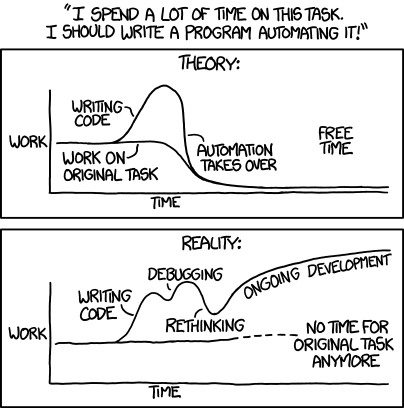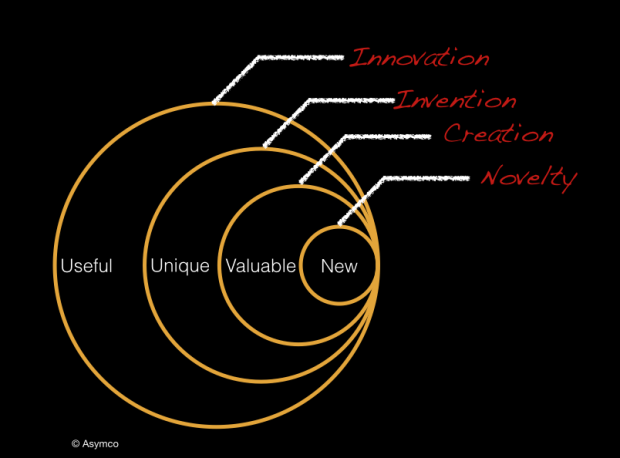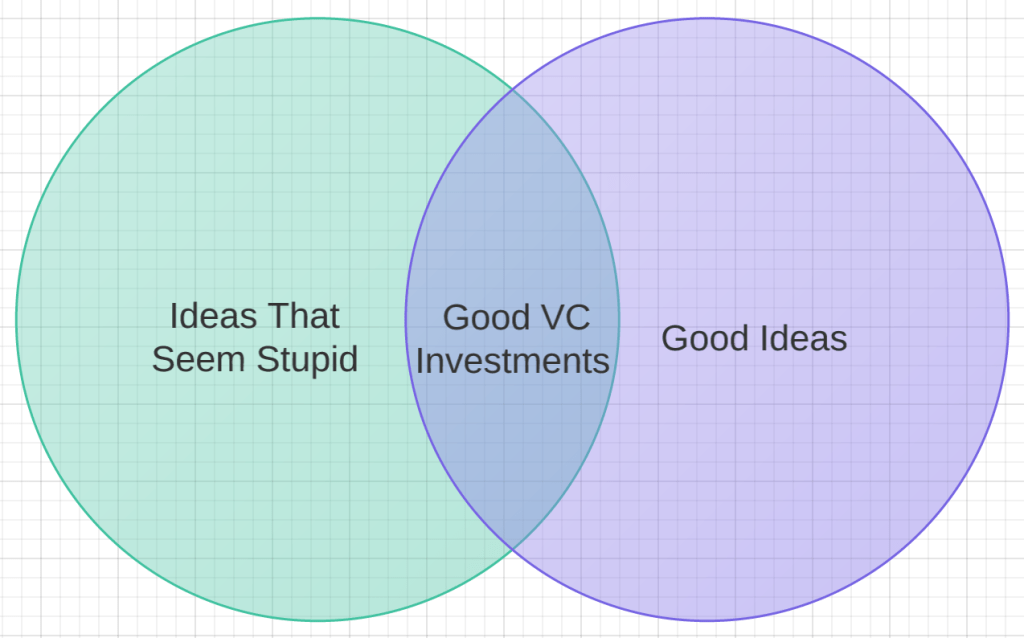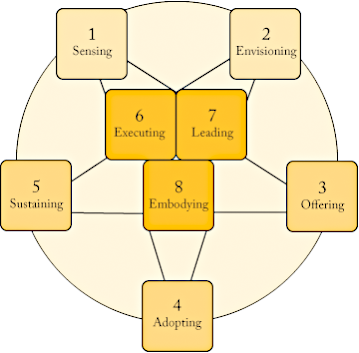Innovation is about finding a better way of doing something. Like many of the new development buzzwords (which many of them are over-used on many business documents), the concept of innovation originates from the world of business. It refers to the generation of new products through the process of creative entrepreneurship, putting it into production, and diffusing it more widely through increased sales. Innovation can be viewed as t he application of better solutions that meet new requirements, in-articulated needs, or existing market needs. This is accomplished through more effective products, processes, services, technologies, or ideas that are readily available to markets, governments and society. The term innovation can be defined as something original and, as a consequence, new, that “breaks into” the market or society.
Innoveracy: Misunderstanding Innovation article points out that there is a form of ignorance which seems to be universal: the inability to understand the concept and role of innovation. The way this is exhibited is in the misuse of the term and the inability to discern the difference between novelty, creation, invention and innovation. The result is a failure to understand the causes of success and failure in business and hence the conditions that lead to economic growth. The definition of innovation is easy to find but it seems to be hard to understand. Here is a simple taxonomy of related activities that put innovation in context:
- Novelty: Something new
- Creation: Something new and valuable
- Invention: Something new, having potential value through utility
- Innovation: Something new and uniquely useful
The taxonomy is illustrated with the following diagram.
The differences are also evident in the mechanisms that exist to protect the works: Novelties are usually not protectable, Creations are protected by copyright or trademark, Inventions can be protected for a limited time through patents (or kept secret) and Innovations can be protected through market competition but are not defensible through legal means.
Innovation is a lot of talked about nowdays as essential to businesses to do. Is innovation essential for development work? article tells that innovation has become central to the way development organisations go about their work. In November 2011, Bill Gates told the G20 that innovation was the key to development. Donors increasingly stress innovation as a key condition for funding, and many civil society organisations emphasise that innovation is central to the work they do.
Some innovation ideas are pretty simple, and some are much more complicated and even sound crazy when heard first. The is place for crazy sounding ideas: venture capitalists are gravely concerned that the tech startups they’re investing in just aren’t crazy enough:
Not all development problems require new solutions, sometimes you just need to use old things in a slightly new way. Development innovations may involve devising technology (such as a nanotech water treatment kit), creating a new approach (such as microfinance), finding a better way of delivering public services (such as one-stop egovernment service centres), identifying ways of working with communities (such as participation), or generating a management technique (such as organisation learning).
Theorists of innovation identify innovation itself as a brief moment of creativity, to be followed by the main routine work of producing and selling the innovation. When it comes to development, things are more complicated. Innovation needs to be viewed as tool, not master. Innovation is a process, not a one time event. Genuine innovation is valuable but rare.
There are many views on the innovation and innvation process. I try to collect together there some views I have found on-line. Hopefully they help you more than confuze. Managing complexity and reducing risk article has this drawing which I think pretty well describes innovation as done in product development:
8 essential practices of successful innovation from The Innovator’s Way shows essential practices in innovation process. Those practices are all integrated into a non-sequential, coherent whole and style in the person of the innovator.
In the IT work there is lots of work where a little thinking can be a source of innovation. Automating IT processes can be a huge time saver or it can fail depending on situation. XKCD comic strip Automation as illustrates this:

System integration is a critical element in project design article has an interesting project cost influence graphic. The recommendation is to involve a system integrator early in project design to help ensure high-quality projects that satisfy project requirements. Of course this article tries to market system integration services, but has also valid points to consider.
Core Contributor Loop (CTTDC) from Art Journal blog posting Blog Is The New Black tries to link inventing an idea to theory of entrepreneurship. It is essential to tune the engine by making improvements in product, marketing, code, design and operations.






5,690 Comments
Tomi Engdahl says:
No, the laws of physics are not time-symmetric
Whether you run the clock forward or backward, most of us expect the laws of physics to be the same. A 2012 experiment showed otherwise.
https://bigthink.com/starts-with-a-bang/laws-physics-not-time-symmetric/#Echobox=1687414477
Tomi Engdahl says:
https://www.discovermagazine.com/the-sciences/quantum-physics-is-no-more-mysterious-than-crossing-the-street?utm_campaign=organicsocial&utm_content=%F0%9F%94%84from_the_archive%3A_accord&utm_medium=social&utm_source=facebook&fbclid=IwAR2RQADqmM5iS7bmuG4pNDLI87kaFm8kALI_hGR8VGO_9jm3o3qDTVYt11I
Tomi Engdahl says:
A 79-year-old mathematician may have just solved an infinite dimension puzzle that’s vexed theorists for decades
News
By Nathan Brownlowe published 15 June 2023
Mathematician Per Enflo, who solved a huge chunk of the ‘invariant subspaces problem’ decades ago, may have just finished his work.
https://theconversation.com/has-a-mathematician-solved-the-invariant-subspace-problem-and-what-does-that-even-mean-206859
Tomi Engdahl says:
https://www.hackster.io/news/a-new-more-efficient-deep-blue-oled-could-boost-brightness-and-lifespan-in-future-displays-e6ceaf245934
Tomi Engdahl says:
https://www.pcgamer.com/researchers-smash-energy-density-record-for-rechargeable-lithium-batteries/
Researchers smash ‘energy density’ record for rechargeable lithium batteries
By Jorge Jimenez published 11 days ago
The first ever 711 Wh/kg rechargeable lithium battery isn’t ready for practical use, but it’s exciting for mobile electronics
Tomi Engdahl says:
The Most Important Machine That Was Never Built
By
SHEON HAN
May 3, 2023
When he invented Turing machines in 1936, Alan Turing also invented modern computing.
https://www.quantamagazine.org/alan-turings-most-important-machine-was-never-built-20230503?fbclid=IwAR3gOYHsferTXGFBsEVkthkldAF0IFYWgVcqQfuABh0GKos5LUjhLMfPJGw
Tomi Engdahl says:
The Battle to Invent the Automatic Rice Cooker
The biggest names in Japanese technology vied to bring them to market
https://www.atlasobscura.com/articles/rice-cooker-history
Tomi Engdahl says:
QUANTUM PHYSICS
Quantum Theory’s ‘Measurement Problem’ May Be a Poison Pill for Objective Reality
Solving a notorious quantum quandary could require abandoning some of science’s most cherished assumptions about the physical world
https://www.scientificamerican.com/article/quantum-theorys-measurement-problem-may-be-a-poison-pill-for-objective-reality/
Tomi Engdahl says:
https://www.scientificamerican.com/article/quantum-theorys-measurement-problem-may-be-a-poison-pill-for-objective-reality/
Tomi Engdahl says:
Research takes first steps towards realizing mechanical qubits
https://phys.org/news/2023-06-mechanical-qubits.html
Quantum information (QI) processing may be the next game changer in the evolution of technology, by providing unprecedented computational capabilities, security and detection sensitivities. Qubits, the basic hardware element for quantum information, are the building block for quantum computers and quantum information processing, but there is still much debate on which types of qubits are actually the best.
Tomi Engdahl says:
Synthetic Human Embryos Have Been Made In A Lab For First Time, Scientists Say
The landmark announcement could be a game-changer for research, but sparks questions for regulators.
https://www.iflscience.com/synthetic-human-embryos-have-been-made-in-a-lab-for-first-time-scientists-say-69398
Tomi Engdahl says:
Unlocking Photonic Computing Power with Artificial ‘Life’
https://www.caltech.edu/about/news/unlocking-photonic-computing-power-with-artificial-life?utm_medium=social-organic&utm_campaign=research-news&utm_source=facebook&fbclid=IwAR0nNeB9RbB-T7rWhdlZ68CCFP_OnKIeDH22iz6U9JgbsNmP9r2u60jNR-g
Cellular automata
To fully grasp the hardware Marandi’s group designed, it is important to understand what cellular automata are and how they work. Technically speaking, they are computational models, but that term does little to help most people understand them. It is more helpful to think of them as simulated cells that follow a very basic set of rules (each type of automata has its own set of rules). From these simple rules can emerge incredibly complex behaviors. One of the best-known cellular automata, called The Game of Life or Conway’s Game of Life, was developed by English mathematician John Conway in 1970.
Ideal for Photonic Computing
Marandi says cellular automata are well suited to photonic computing for a couple of reasons. Since information processing is happening at an extremely local level (remember in cellular automata, cells interact only with their immediate neighbors), they eliminate the need for much of the hardware that makes photonic computing difficult: the various gates, switches, and devices that are otherwise required for moving and storing light-based information. And the high-bandwidth nature of photonic computing means cellular automata can run incredibly fast. In traditional computing, cellular automata might be designed in a computer language, which is built upon another layer of “machine” language below that, which itself sits atop the binary zeroes and ones that make up digital information.
In contrast, in Marandi’s photonic computing device, the cellular automaton’s cells are just ultrashort pulses of light, which can allow operation up to three orders of magnitude quicker than the fastest digital computers.
Tomi Engdahl says:
https://viralonce.xyz/scientists-discover-an-ancient-protoplanet-in-africa-that-is-older-than-the-earth/#lir2e03lj0rqbh0z8n
Tomi Engdahl says:
KISS method for 2D material preparation: Unlocking new possibilities for materials science
https://phys.org/news/2023-06-method-2d-material-possibilities-materials.html
Tomi Engdahl says:
https://www.etteplan.com/stories/industry-50-three-steps?utm_source=facebook&utm_medium=paid&utm_campaign=SES_Industrial_digitalization_23-04-06_en&utm_content=article_industry-5-0-three-steps&fbclid=IwAR0ZZXjn2U-cnvQXjqW9tHFQZzaPC7Y8-rrOG5xK38k6W-iGnnuBQI44_Hk_aem_th_ATaNxl5IGLmsm_QuippPQbABIrFv3K-08db4Zl49gfkPZSLLgfQ038U4XJQ1HxolP1SojFyQ-hHXCE7E4H_gtD5P
Tomi Engdahl says:
Bob Kahn on the Birth of “Inter-networking” A codeveloper of TCP/IP explains what led to his collaboration with Vint Cerf
https://spectrum.ieee.org/bob-kahn
IEEE Spectrum recently published a profile of Vint Cerf, who together with Bob Kahn developed what later became known as TCP/IP, the suite of protocols that power the Internet. That article didn’t detail the events leading up to their influential technical collaboration, though. So IEEE Spectrum talked with Kahn to learn this part of the story and his conception of open-architecture networking.
Tomi Engdahl says:
In the field of superconductivity—the phenomenon in which electrons can flow through a material with essentially zero resistance—the “holy grail” of discovery is a superconductor that can perform under everyday temperatures and pressures.
First direct visualization of a zero-field pair density wave
https://phys.org/news/2023-07-visualization-zero-field-pair-density.html?fbclid=IwAR1GX9FrkNmOY5kZspYzmCNjwwsVLActazQQlqOFnFR5tshXOoYtWfnIjrs
Tomi Engdahl says:
Five Big Ideas Shaping Tomorrow
From space manufacturing to AI medicine, keep these trends on your radar…
https://www.wired.co.uk/bc/article/five-big-ideas-shaping-tomorrow-hsbc-global-private-banking?utm_source=facebook&utm_medium=social&utm_campaign=paid-spon-citizennet_Q22023&fbclid=IwAR3BaCjF7szPdC4AHfkZngPNDQZaXpCgTOy3GXRBwI898YRyWrv0-8ebkmc_aem_AY2zyNYG2UEDN-tiMftAnR_GWj2RgZ4krEGIBZWOln1vN6lstEWEjLU-9mGPmYKPBRx1jZOPfLCkkN7obTLOsqXu
We have shone a light on five nascent ideas that share a few common characteristics. All of them are enjoying serious venture capital flows and all of them attempt to solve genuine problems. What’s more, they are attracting attention from credible experts. For each story we’ve interviewed one of them, to hear why they’re excited but also what challenges still need to be solved.
The five big ideas are:
How Factories in Space Could Solve Problems on Earth
Why Touch is VR’s Missing Ingredient
Harnessing the Ocean Could Help Fight Climate Change
Generative AI Will Transform Medicine
Will India be the Next Semiconductor Superpower?
“These ideas aren’t science fiction—they are real things, and they’re starting to happen right now. One group that should be following these developments is investors. While it may not be straightforward to get direct exposure to the specific area, investors need to consider investing in the underlying trend” says Willem Sels, global CIO of HSBC Global Private Banking. “The question is how these ideas evolve from here—but if they do take hold, then they could change our world for the better.”
Tomi Engdahl says:
Yes, You Can Control Your Dreams: The Strange Science of Lucid Dreaming
Once dismissed as a new age fad, lucid dreaming has gained attention as a possible performance enhancer and therapeutic tool.
https://www.discovermagazine.com/mind/yes-you-can-control-your-dreams-the-strange-science-of-lucid-dreaming
Tomi Engdahl says:
Physicists generate first snapshots of fermion pairs, shed light on how electrons form superconducting pairs
https://phys.org/news/2023-07-physicists-generate-snapshots-fermion-pairs.html?fbclid=IwAR2ciwJeLb7RRqJNfWk2QEU37Do_lenKNrwf_Cj2VW3JVvzQQ5l5mYK69t8
When your laptop or smartphone heats up, it’s due to energy that’s lost in translation. The same goes for power lines that transmit electricity between cities. In fact, around 10 percent of the generated energy is lost in the transmission of electricity. That’s because the electrons that carry electric charge do so as free agents, bumping and grazing against other electrons as they move collectively through power cords and transmission lines. All this jostling generates friction, and, ultimately, heat.
But when electrons pair up, they can rise above the fray and glide through a material without friction. This “superconducting” behavior occurs in a range of materials, though at ultracold temperatures. If these materials can be made to superconduct closer to room temperature, they could pave the way for zero-loss devices, such as heat-free laptops and phones, and ultraefficient power lines. But first, scientists will have to understand how electrons pair up in the first place.
Tomi Engdahl says:
https://hackaday.com/2023/07/06/its-a-humble-scope-but-it-changed-our-world/
Tomi Engdahl says:
This oscilloscope made history! Used to design both Pong and the Apple II.
https://www.youtube.com/watch?v=62_WDBjZGGs
USED TO LAUNCH THE DIGITAL REVOLUTION, TWICE: This oscilloscope was used to design Pong, the birth of the video game industry, and the Apple II, the first personal computer with hi-res color graphics. The present oscilloscope is a remarkable artifact, having played a critical role in launching two of the most consequential products in the history of the digital revolution. For more information, please visit manhattanrarebooks.com.
Tomi Engdahl says:
Japanese researchers find a simple and affordable way to store hydrogen
It does not involve pressurized containers and can be retrieved at relatively low temperatures.
https://interestingengineering.com/science/simple-affordable-way-store-hydrogen-perovskite
Tomi Engdahl says:
The Difference Between Mind Wandering and Mind Wondering
https://www.templeton.org/news/the-difference-between-mind-wandering-and-mind-wondering
Curiosity has long been associated with creativity and artistic expression. As Zora Neale Hurston once put it,
“Research is formalized curiosity. It is poking and prying with a purpose.”
Tomi Engdahl says:
Photonic time crystals could open the door to a new branch of optics
https://phys.org/news/2023-07-photonic-crystals-door-optics.html
Tomi Engdahl says:
https://www.templeton.org/news/the-difference-between-mind-wandering-and-mind-wondering
Tomi Engdahl says:
Electrons are extremely round, a new measurement confirms
The result deepens the mystery behind why there’s more matter than antimatter in the universe
https://www.sciencenews.org/article/electron-round-new-measurement-matter-physics
Tomi Engdahl says:
Machine learning enables accurate electronic structure calculations at large scales for material modeling
https://phys.org/news/2023-07-machine-enables-accurate-electronic-large.html#google_vignette
Tomi Engdahl says:
https://www.quantamagazine.org/elliptic-curves-yield-their-secrets-in-a-new-number-system-20230706/?fbclid=IwAR3Q5JZcmfP6LF0OM8puiE6Zx0wigFdNcGFZhfxGxHzIl-EI9VtEeMOvRRw
Tomi Engdahl says:
https://www.extremetech.com/science/scientists-stretch-metal-to-discovery-superconductivity-switch
Tomi Engdahl says:
https://futurism.com/the-byte/groundwater-extraction-polar-shift
Tomi Engdahl says:
Tiny Wells Prove Perfect for Growing Perovskite Crystals for Nano-Scale LEDs, Researchers Say
Providing a way to grow the crystals with an accuracy of 50 nanometers, this new platform could revolutionize nano-scale electronics
https://www.hackster.io/news/tiny-wells-prove-perfect-for-growing-perovskite-crystals-for-nano-scale-leds-researchers-say-f2583e5c5375
Tomi Engdahl says:
Researchers use liquid crystals that mimic beetle shell coloration units to create a more secure type of QR code
https://phys.org/news/2023-07-liquid-crystals-mimic-beetle-shell.html
Tomi Engdahl says:
Researchers create an optical tractor beam that pulls macroscopic objects
https://phys.org/news/2023-01-optical-tractor-macroscopic.html#amp_tf=L%C3%A4hde%3A%20%251%24s&aoh=16893673061329&referrer=https%3A%2F%2Fwww.google.com&share=https%3A%2F%2Fphys.org%2Fnews%2F2023-01-optical-tractor-macroscopic.html
Tomi Engdahl says:
Microsoft’s light-based computer marks ‘the unravelling of Moore’s Law’
By Katie Wickens published 15 days ago
Analog, iterative machines ditch binary transistor switches for photons and electrons to process at the speed of light.
https://www.pcgamer.com/microsofts-light-based-computer-marks-the-unravelling-of-moores-law/
Tomi Engdahl says:
Scientists for the first time have witnessed pieces of metal crack, then fuse back together without any human intervention, overturning fundamental scientific theories in the process.
‘Stunning’ discovery: Metals can heal themselves
https://phys.org/news/2023-07-stunning-discovery-metals.html?fbclid=IwAR1_fc5wZg5vOJowHR4q034wyf-UmHGmU7bTPerrkpq71lm6EHMT0hMWrNc#google_vignette
Scientists for the first time have witnessed pieces of metal crack, then fuse back together without any human intervention, overturning fundamental scientific theories in the process. If the newly discovered phenomenon can be harnessed, it could usher in an engineering revolution—one in which self-healing engines, bridges and airplanes could reverse damage caused by wear and tear, making them safer and longer-lasting.
“This was absolutely stunning to watch first-hand,” said Sandia materials scientist Brad Boyce.
“What we have confirmed is that metals have their own intrinsic, natural ability to heal themselves, at least in the case of fatigue damage at the nanoscale,” Boyce said.
Fatigue damage is one way machines wear out and eventually break. Repeated stress or motion causes microscopic cracks to form. Over time, these cracks grow and spread until—snap! The whole device breaks, or in the scientific lingo, it fails.
The fissure Boyce and his team saw disappear was one of these tiny but consequential fractures—measured in nanometers.
“From solder joints in our electronic devices to our vehicle’s engines to the bridges that we drive over, these structures often fail unpredictably due to cyclic loading that leads to crack initiation and eventual fracture,” Boyce said. “When they do fail, we have to contend with replacement costs, lost time and, in some cases, even injuries or loss of life. The economic impact of these failures is measured in hundreds of billions of dollars every year for the U.S.”
Unexpected discovery confirmed by theory’s originator
In 2013, Michael Demkowicz—then an assistant professor at the Massachusetts Institute of Technology’s department of materials science and engineering, now a full professor at Texas A&M—began chipping away at conventional materials theory. He published a new theory, based on findings in computer simulations, that under certain conditions metal should be able to weld shut cracks formed by wear and tear.
They only meant to evaluate how cracks formed and spread through a nanoscale piece of platinum using a specialized electron microscope technique they had developed to repeatedly pull on the ends of the metal 200 times per second.
Surprisingly, about 40 minutes into the experiment, the damage reversed course. One end of the crack fused back together as if it was retracing its steps, leaving no trace of the former injury. Over time, the crack regrew along a different direction.
Hattar called it an “unprecedented insight.”
Boyce, who was aware of the theory, shared his findings with Demkowicz.
“I was very glad to hear it, of course,” Demkowicz said. The professor then recreated the experiment on a computer model, substantiating that the phenomenon witnessed at Sandia was the same one he had theorized years earlier.
A lot remains unknown about the self-healing process, including whether it will become a practical tool in a manufacturing setting.
“The extent to which these findings are generalizable will likely become a subject of extensive research,” Boyce said. “We show this happening in nanocrystalline metals in vacuum. But we don’t know if this can also be induced in conventional metals in air.”
Tomi Engdahl says:
Nothing strange about this pentaquark’s ‘strangeness’
The Large Hadron Collider yields a five-quark particle that includes a ‘strange’ quark, as predicted by theory.
https://www.nature.com/articles/d41586-023-02258-5?utm_term=Autofeed&utm_campaign=nature&utm_medium=Social&utm_source=Facebook&fbclid=IwAR0H-XKZ96JrzfY3Ij8OIwSJ9H0nvJUE3mxIAhg-k9gzQ3L4_eQP0SNrEVU#Echobox=1689962151
Tomi Engdahl says:
Unveiling the quantum dance: Experiments reveal nexus of vibrational and electronic dynamics
https://phys.org/news/2023-07-unveiling-quantum-reveal-nexus-vibrational.html?fbclid=IwAR1j-8LDkq7ohCB5IDNuSyRZIUppWIlXYaKhqQ8_KEvDoj99Hc37qOa8aG0
Tomi Engdahl says:
1968 “Mother of All Demos” with Doug Engelbart & Team (1/3) [re-mastered]
https://www.youtube.com/watch?v=UhpTiWyVa6k
Tomi Engdahl says:
Läpimurto ydinfysiikassa – Henna Kokkosen gradua siteerattiin maailman tiedejulkaisuissa
Harvinainen saavutus on lyönyt ällikällä jopa Kokkosen perheen, joka ei ihan tarkkaan tiennyt, mitä ydinfysiikan laboratoriossa tehdään.
https://www.hs.fi/kotimaa/art-2000009735040.html
Tomi Engdahl says:
tuntinen elokuva atomipommin isästä on erittäin hyvä eikä sisällä turhia kohtauksia
Christopher Nolanin kunnianhimoinen elokuva kertoo atomipommin isästä J. Robert Oppenheimerista.
https://www.hs.fi/kulttuuri/art-2000009694331.html
Tomi Engdahl says:
Shrinking light: Waveguiding scheme enables highly confined subnanometer optical fields
https://phys.org/news/2023-07-waveguiding-scheme-enables-highly-confined.html
Tomi Engdahl says:
If You’re Lacking in Sunny Days, These Rain Panels Could Generate Energy Instead
If things are looking a little cloudy, you could be powering your home — with up to 200W per meter square of energy harvesting.
https://www.hackster.io/news/if-you-re-lacking-in-sunny-days-these-rain-panels-could-generate-energy-instead-11562feb4b01
Researchers from Tsinghua University, the China Electric Power Research Institute, the Chinese Academy of Sciences, State Grid Qingdao Power Supply Company, and the Georgia Institute of Technology have proposed an alternative to solar panels for regions where rain is more likely than sunshine — by using triboelectric nanogenerators (D-TENGs) to turn rain drops in to electricity.
Based on technology already used in wave-based energy harvesting systems, the team’s approach is simple: an array of nanogenerators attached, just like solar panels, to a building’s roof. Where a solar panel array turns sunlight into electricity, though, these D-TENG arrays capture the energy from falling drops of rain — making them a better bet in regions where the number of rainy days are vastly greater than the sunny ones.
The team’s approach seems considerably more scalable than alternatives, boasting a near-fivefold increase in the amount of energy that can be generated in a given area.
“reaching 200 watts per square meter, which fully shows its advantages in large-area raindrop energy harvesting. The results of this study will provide a feasible scheme for large-area raindrop energy harvesting.”
https://ieeexplore.ieee.org/document/10185664
Tomi Engdahl says:
A New Twist on Brain-Computer Interfaces
This soft, noninvasive in-ear brain-computer interface can read your mind without being cumbersome or interfering with normal hearing.
https://www.hackster.io/news/a-new-twist-on-brain-computer-interfaces-568699e270e1
Tomi Engdahl says:
Van der Waals crust behind simple parameter that can describe chemical bonds
https://www.chemistryworld.com/news/van-der-waals-crust-behind-simple-parameter-that-can-describe-chemical-bonds/4017719.article
Tomi Engdahl says:
https://www.caltech.edu/about/news/evolving-and-3d-printing-new-nanoscale-optical-devices?utm_medium=social-organic&utm_campaign=research-news&utm_source=facebook&utm_content&utm_term&fbclid=IwAR3v51bROxE4P2l3lsuGvLmViC-6T7KutiHkZs7QOJxgO0g2Kcse3sL6EXQ
Tomi Engdahl says:
First Room-Temperature Ambient-Pressure Superconductor Achieved, Claim Scientists
Someone with a lab please try to reproduce these results so we know if we should pop the champagne.
https://www.iflscience.com/first-room-temperature-ambient-pressure-superconductor-achieved-claim-scientists-70001
South Korean scientists have announced the development of a room-temperature ambient-pressure superconductor. If the claim is verified, this will change the world. Superconductors transmit electricity without resistance and have a series of magnetic properties that make them invaluable in technological applications. Usually, superconductors need to be cooled down to very low temperatures. A superconductor capable of working outside the lab in regular conditions would be revolutionary.
Tomi Engdahl says:
A new approach to developing semiconductor materials at tiny scales could help boost applications that rely on converting light to energy. Here’s what happened when a Los Alamos-led team incorporated magnetic dopants into specially engineered colloidal quantum dots.
A new ‘spin’ on carrier multiplication in quantum dots
https://discover.lanl.gov/news/0713-quantum-dots/?fbclid=IwAR1FFm-dfiR_1ExarH9tZsrIk8X1G_qjFjyB897upsl8tgXeNz4Dn4d06nw
Carrier multiplication effect driven by spin-flip transitions of manganese dopants may boost technologies including photoinduced chemistry, photodetection and solar cells
Tomi Engdahl says:
Tutkijat kehittivät aurinkopaneelin kaltaisen laitteen, joka tuottaa vesipisaroista sähköä – Huipputeho 200 W/m²
Tsinghua-yliopiston tutkimuksessa paranneltiin aikaisemmin ehdotettua hankaussähköön perustuvaa nanogeneraattoria.
https://www.tekniikkatalous.fi/uutiset/tutkijat-kehittivat-aurinkopaneelin-kaltaisen-laitteen-joka-tuottaa-vesipisaroista-sahkoa-huipputeho-200-w-m/f7b97ed0-63e0-4592-8be0-277d314802c2
Tomi Engdahl says:
https://www.edn.com/lightning-as-an-energy-harvesting-source/